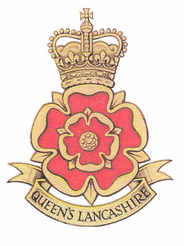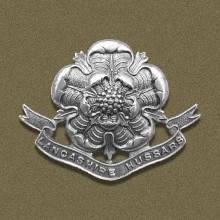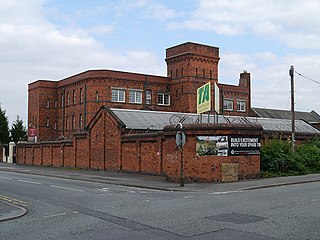
The King's Regiment, officially abbreviated as KINGS, was an infantry regiment of the British Army, part of the King's Division. It was formed on 1 September 1958 by the amalgamation of the King's Regiment (Liverpool) which had been raised in 1685 and the Manchester Regiment which traced its history to 1758. In existence for almost 50 years, the regular battalion, 1 KINGS, served in Kenya, Kuwait, British Guiana (Guyana), West Germany, Northern Ireland, the Falkland Islands, Cyprus, and Iraq. Between 1972 and 1990, 15 Kingsmen died during military operations in Northern Ireland during a violent period in the province's history known as "The Troubles".

The Queen's Lancashire Regiment (QLR) was an infantry regiment of the British Army, part of the King's Division. It was formed on 25 March 1970 at Connaught Barracks in Dover through the amalgamation of the two remaining Lancashire infantry regiments, the Lancashire Regiment and the Loyal Regiment. In July 2006 the regiment was amalgamated with two other Northern infantry regiments to form the Duke of Lancaster's Regiment.

The Duke of Lancaster's Regiment (LANCS) is an infantry regiment of the line within the British Army, part of the King's Division. Headquartered in Preston, it recruits throughout the North West of England. The Duke of Lancaster is a title inherent in the Sovereign and as such does not vary with the Sovereign's gender.

The South Lancashire Regiment was a line infantry regiment of the British Army in existence from 1881 to 1958.

The King's Own Royal Border Regiment was an infantry regiment of the British Army in existence from 1959 until 2006, and was part of the King's Division. It was formed at Barnard Castle on 1 October 1959 through the amalgamation of the King's Own Royal Regiment (Lancaster) and the Border Regiment. The only official abbreviation of the name was King's Own Border [sic].
The Lancastrian and Cumbrian Volunteers was a Territorial Army unit of the British Army.
The King's and Cheshire Regiment was a regiment of the British Territorial Army, with headquarters in Warrington, Cheshire.

The 42nd Infantry Brigade, also known as 42 Brigade, was a brigade of the British Army.
The Lancastrian Brigade was an administrative formation of the British Army from 1948 to 1968. The Brigade administered the regular infantry regiments of northwest England.
The 25th Division was an infantry division of the British Army, raised as part of Lord Kitchener's Third New Army (K3) in September 1914, shortly after the outbreak of the Great War. It served on the Western Front for most of the war.

The Duke of Lancaster's Own Yeomanry was a British Army regiment that existed from 1798 to 1992. The regiment sent mounted infantry for service in the Second Boer War as the Imperial Yeomanry, between 1900 and 1902, and also saw action during the First and Second World Wars. Its lineage is maintained by B Squadron, the Queen's Own Yeomanry.

The Lancashire Hussars was a British Army unit originally formed in 1798. It saw action in the Second Boer War, the First World War and the Second World War. In 1969, the regiment reduced to a cadre and the Yeomanry lineage discontinued.

Peninsula Barracks is a military installation on O'Leary Street in Warrington, England.
The Lancashire Militia was an auxiliary military force in Lancashire in North West England. From their formal organisation as Trained Bands in 1558 and their service in the Williamite War in Ireland and against the Jacobite Risings, the Militia regiments of Lancashire served during times of international tension and all of Britain's major wars. They provided internal security and home defence but sometimes operated further afield, including Ireland and the Mediterranean, relieving regular troops from routine garrison duties, and acting as a source of trained officers and men for the Regular Army. All the infantry battalions went on active service during the Second Boer War and all served as Special Reserve training units in World War I, with one battalion seeing considerable action on the Western Front. After 1921 the militia had only a shadowy existence until its final abolition in 1953.

The Phoenix Street drill hall is a former military installation in Lancaster, Lancashire.

The 5th Battalion, King's Regiment (Liverpool) was a volunteer unit of the King's Regiment (Liverpool) of the British Army, part of the Territorial Force (TF).
The 4th Royal Lancashire Militia was an auxiliary regiment raised in the county of Lancashire in North West England just before the Crimean War. It later became part of the South Lancashire Regiment. Although primarily intended for home defence, it saw considerable active service during the Second Boer War. After conversion to the Special Reserve (SR) under the Haldane Reforms it supplied reinforcements to the fighting battalions during World War I and carried out internal security duties in Ireland. After a shadowy postwar existence the unit was finally disbanded in 1953.
The 1st Royal Lancashire Militia was an auxiliary regiment raised in the county of Lancashire in North West England during the 17th Century. Primarily intended for home defence, it saw active service in Ireland under King William III, as well as against the Jacobite Risings of 1715 and 1745. It spent long periods on defence duties during the wars of the 18th Century and early 19th Century, and was stationed on the Ionian Islands during the Crimean War. It later became part of the King's Own and saw active service in the Second Boer War. After its conversion to the Special Reserve under the Haldane Reforms, it supplied reinforcements to the fighting battalions during World War I. After a shadowy postwar existence the unit was finally disbanded in 1953.

Kimberley Barracks is a military installation on Deepdale Road in Preston in Lancashire, England PR1 6PR.










